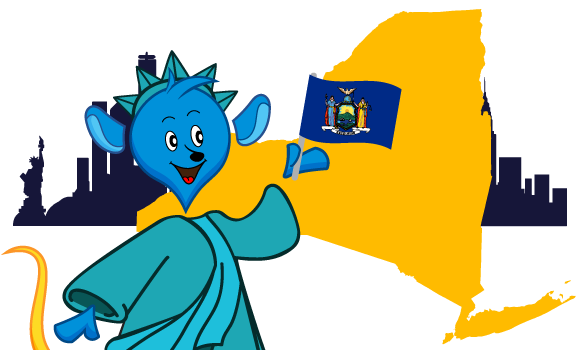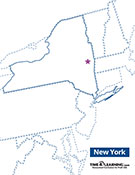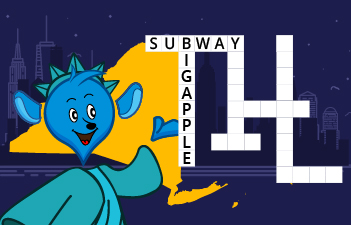Located in the northeastern United States, New York is one of the most recognized states in the world. Its largest city, New York City, is home to an impressive array of skyscrapers, as well as many well-known tourist attractions including the Statue of Liberty, Times Square, and Central Park.
With so much to learn about the history, geography, and culture of the state, your child will enjoy this study of New York, one of Time4Learning’s series of United States unit study supplements.
Also included are learning games that allow you to test your knowledge of New York facts. Explore all the activities in the Empire State, plus deals and freebies for homeschoolers. You can also download our list of PreK-12 interactive activities that align with your study of interesting facts about New York.
New York Fast Facts
| Became a State |
July 26, 1788 |
| Order it Joined the Union |
11th state |
| State Capital |
Albany |
| State Abbreviation |
NY |
| Border States | |
| State Flag |  |
| State Song |
I Love New York |
| State Flower |
Rose |
| State Nickname |
|
| Notable New Yorkers |
|
Historical Facts About New York
Before the first Europeans arrived in New York, the state was home to several Native American tribes, mostly Algonquian and Iroquois. In the early 17th century, English explorer Henry Hudson arrived in the area, representing the Dutch. The Hudson River, Hudson Strait, and Hudson Bay were all named after him.
The Dutch established a number of trading posts in the colony of New Netherland around this time. This made it possible for them to trade with various tribes in the area. The colony was eventually captured by the English during the Second Anglo-Dutch War, although the Dutch ultimately won the war. The seat of the colonial government was New Amsterdam, which is located in present-day lower Manhattan. In 1664, after the English captured the settlement, it was renamed New York for James, the Duke of York.
The American Revolutionary War began in 1775 between the British and the 13 colonies. As a result of the war, the Continental Army was created, with George Washington serving as its commander-in-chief. Although the war started in Massachusetts, a third of the battles took place in New York.
In 1783, the Treaty of Paris put an end to the war. Soon after, the last of the British troops left the state. On July 26, 1788, New York became the 11th state to ratify the Constitution.
The timeline below makes online learning for kids fast, simple and easy by highlighting important dates in the history of the Empire State as well as interesting facts about New York.
1614
The Dutch rebuilt an abandoned French chateau on Castle Island (present-day Albany) and named it Fort Nassau, making it the first Dutch settlement in North America. The fort was washed away by flooding in 1617.
1776
The Battle of Long Island (Battle of Brooklyn), the largest battle of the American Revolutionary War, took place in New York on August 27. The British claimed victory over the Americans who retreated to Pennsylvania.
1785
New York City became the capital of the United States until 1790, under the Articles of Confederation and Perpetual Union.
1792
The New York Stock Exchange was founded in New York City.
1797
Albany became the capital of New York. Today, it is the sixth largest city in the state.
1883
The Brooklyn Bridge opened on May 24. It connects Manhattan and Brooklyn.
1885
The Statue of Liberty arrived in New York from France. The official dedication ceremony took place the following year.
1892
Ellis Island opened and welcomed more than 12 million immigrants to the U.S. until it closed in 1954.
1902
The Flatiron building, New York City’s first skyscraper, was built.
1904
The New York City Subway began operation. It is the busiest rapid transit system in North America, with approximately 1.7 billion annual riders.
1930
Construction of the Chrysler Building was completed on May 27. It was constructed by Walter Chrysler, head of the American car brand of the same name. The building served as the corporation’s headquarters from 1930 to the mid-1950s.
1931
The Empire State Building opens on Fifth Avenue in Manhattan. From 1931 to 1970, it was the tallest building in the world.
1952
New York City became the headquarters of the United Nations.
1973
The World Trade Center was completed.
1977
The tourism campaign “I LOVE NEW YORK” was created to improve the state’s economy.
2001
Terrorists flew two hijacked planes into the World Trade Center’s Twin Towers in New York City, causing both towers to collapse and killed 2,753 people, including 147 aboard the planes.
Bring history and geography to life with Time4Learning’s interactive online social studies curriculum for grades 2-12.
Geographical Facts About New York
Even though New York is ranked 27th in land area, the state is ranked 4th in population, with almost 20 million residents in 2017. Over 40% of the population resides in New York City, making it the largest city in the country. The state’s diverse geography includes several mountain ranges, coastal borders, forests, and farms.
When studying New York geography, start by having your homeschooler locate the state on this printable U.S. map. To get a more in-depth view, explore this map of the state, then download our printable New York map below and have your child label important cities and landmarks. Learn more about New York’s geography and its unique features with these interesting facts.
- There are 62 counties and 62 cities in the state.
- The smallest city is Sherrill in Oneida County, just a few miles from the geographic center of the state. In 2010, it had a population of just over 3,000.
- Mount Marcy, in the northeast, is home to the highest point in the state, at 5,344 feet. It is located in Adirondack Park, which is the largest state park in the U.S., with over 6 million acres.
- One World Trade Center in New York City is the tallest building in the U.S. at 1,776 feet tall.
- The Finger Lakes are made up of 11 long and narrow lakes in the center of the state. The longest is Seneca Lake at 38.1 miles; it is also the deepest at 618 feet.
- New York City is made up of five boroughs: Manhattan, Brooklyn, Queens, the Bronx, and Staten Island.
- Niagara Falls State Park is the oldest state park in the U.S. It was established in 1885 and is home to the American Falls and a portion of Horseshoe falls. The other portion is in Canada.
- The 315-mile long Hudson River runs from Upstate New York, through the Hudson Valley, between New Jersey and New York, and into the Atlantic Ocean.
- Two Great Lakes border New York on the west: Lake Erie and Lake Ontario.
- New York is the only state that has a border with both the Great Lakes and the Atlantic Ocean.
New York State Map
Download our FREE New York state map printable. Use it as a coloring page or use it to plot the state’s geographical features.
Activities for Children in New York
Do you homeschool in the state of New York? Are you planning a trip to the Empire State soon? Even though you won’t run out of things to do, you may have a hard time deciding where to start! Below are a few field trip ideas that are fun and educational, and will help supplement the New York facts unit study. Have fun!
- Statue of Liberty (New York City) – When in New York, visiting this iconic attraction is a must. Visitors can explore the grounds, go up to the pedestal, or visit the highest point, the crown. In addition to the statue itself, families can also visit the museum or take part in a ranger-led or self-guided tour. Several ticket options are available.
- Niagara Falls State Park (Niagara Falls) – Grab a raincoat and head over to the American side of this breathtaking natural wonder. In addition to taking a once-in-a-lifetime boat tour near the falls, visitors can head to the observation tower, Discovery Center, and the Aquarium.
- American Museum of Natural History (New York City) – At over 2 million square feet — spread among 28 interconnected buildings — this museum is one of the largest in the world. With exhibitions changing on a regular basis, visitors can learn about mammals, human origins and various cultures, planetary sciences, dinosaurs, and more. A number of family programs and workshops are also available.
- Bronx Zoo (Bronx) – Opened in 1899, the Bronx Zoo spans 265 acres and features approximately 4,000 animals — from aardvarks to zebras and everything in between. Exhibits include a petting zoo, butterfly garden, 4-D theater, camel rides, and more.
- Empire State Building (New York City) – This 102-story skyscraper stands 1,454 feet tall. Visitors can take in the sights from either the 86th floor main deck, which features an open-air observatory and 360 degree views of New York, or from the enclosed top deck on the 102nd floor for a more expansive view.
New York Freebies and Deals for Homeschoolers
- Museum of Modern Art (New York City) – Children 16 and under always enjoy free admission at this museum in Midtown Manhattan. Families can also explore and learn thanks to several tours, art workshops and films, all of which are free.
- Central Park (New York City) – Open every day of the year, this most-visited urban park in the U.S. covers a whopping 843 acres. It’s home to the Central Park Zoo, a carousel, an ice skating rink, and more. Families can get in some physical activity at over 20 playgrounds, delight in a number of ornamental fountains and sculptures, or take in the views while enjoying a picnic on one of various verdant lawns. Although getting into the park is free, certain attractions do charge a fee.
- Muscoot Farm (Katonah) – Admission to this Westchester county park that was once a working dairy farm is free. Families can take part in a number of free events like guided hikes, art shows, and more. Several education programs and workshops are also available for a small fee.
- Socrates Sculpture Park (Long Island City) – This outdoor museum, established in 1986, offers admission and education programs free of charge. There are sculpture workshops, self-guided tours, and tons of other events and activities for families to enjoy.
- Staten Island Ferry (New York City) – The 25-minute, 5-mile voyage offers passengers a breathtaking view of the Statue of Liberty, city skyline, Brooklyn Bridge and more. The free, 5-mile trip is approximately 25 minutes and transports passengers from Staten Island to Manhattan.
New York Learning Games for Children
Looking for additional ways to learn fun facts about New York? Want to find out how much your children have learned about the Empire State? The free learning resources below allow you to test their knowledge, and also give your students the opportunity to practice their vocabulary, spelling, and more.











